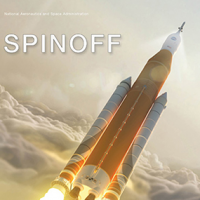NASA Patents and Searchable Database Inspires Spinoff Technology

“That's one small step for man, one giant leap for mankind.” When astronaut Neil Armstrong climbed down the ladder of the Apollo 11 and became the first human to step onto the moon, the historic footprint became an icon for NASA’s discoveries. But the intent always was to share the benefits of the supporting research and technologies for NASA missions here on earth. To that end, NASA’s Technology Transfer Program periodically releases formerly patented technologies used for space missions to the general public for commercial use.
NASA recently made available more than 50 additional agency technologies in the public domain, including advanced manufacturing processes, sensors, propulsion methods, rocket nozzles, thrusters, aircraft wing designs, and improved rocket safety and performance concepts. In addition, a searchable database now catalogs thousands of NASA patents already in the public domain.
The NASA patent portfolio currently includes more than 1,000 technologies in 15 categories, ranging from aeronautics, communications, electronics, environment, health, medicine and biotechnology, IT and software, instrumentation, optics, robotics, automation and control to sensors.
There’s plenty to spark ideas. Here’s some interesting research from the Information Technology and Software portfolio:
- A portfolio of technologies for clock synchronization in distributed systems
- Technology for computer and video game environments that trains mental skills, beyond eye-hand coordination
- An enhanced project management tool for complex systems
- A real-time sonic boom system that can be integrated into a cockpit or flight control room to help pilots place loud booms in specific locations, away from populated areas
If you want to see some examples of NASA technology in action in everyday life, take a look at NASA’s Spinoff 2016. One remarkable use case treats postpartum hemorrhage, a complication that can be fatal to new mothers without ready access to quality medical care. A modified anti-gravity suit or G-suit, the type that NASA uses to keep test pilots from blacking out during extreme acceleration and that astronauts use during re-entry, was modified so it can be used to apply pressure to the lower body, decreasing bleeding and shifting blood back to the heart and brain.
There are plenty of other examples—from advanced diagnostics testing to a more economical way to put bubbles in craft beer.
Flashback: It never gets old. Here’s another look at July 20, 1969: Play Audio, and see the restored video.

